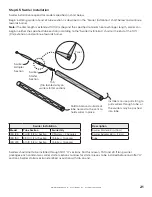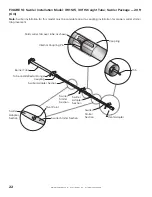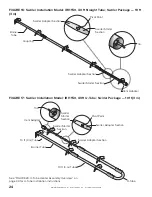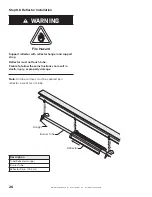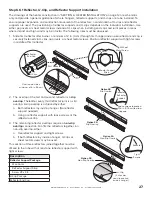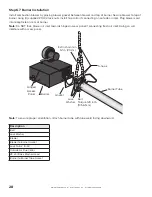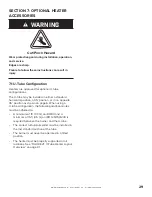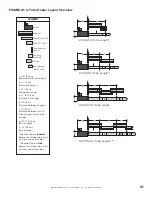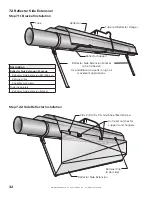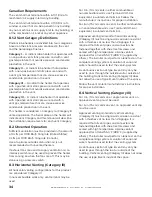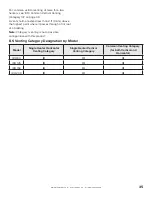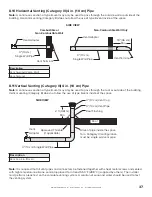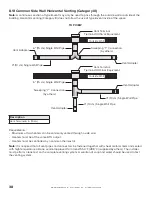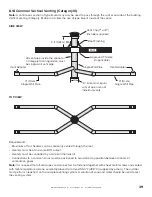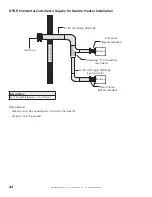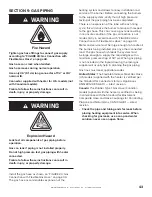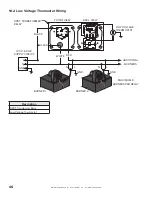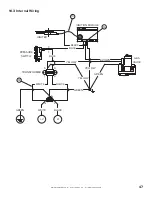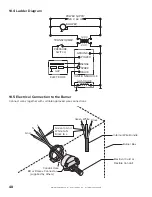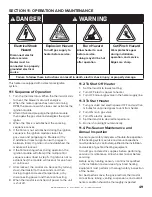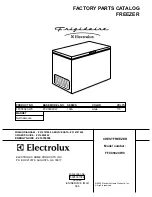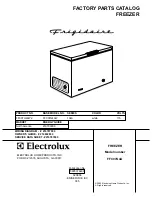
WWW.BIGASSFANS.COM © 2021 DELTA T LLC ALL RIGHTS RESERVED.
34
Canadian Requirements
The vent shall not terminate within 6 ft (1.8 m) of a
mechanical air supply inlet to any building.
The vent shall not terminate within 3 ft (0.9 m) of a
window or door that can be opened in any building,
any non-mechanical air supply inlet to any building, or
of the combustion air inlet of any other appliance.
8.1.2 Vent Category Definitions
Radiant tube heaters are divided into four categories
based on the static pressure produced in the vent
and the percentage flue loss.
Category I
— A radiant tube heater that operates with
a non-positive vent static pressure and with a vent
gas temperature that avoids excessive condensate
production in the vent.
Category II
— A radiant tube heater that operates
with a non-positive vent static pressure and with
a vent gas temperature that can cause excessive
condensate production in the vent.
Category III
— A radiant tube heater that operates
with a positive vent static pressure and with a vent
gas temperature that avoids excessive condensate
production in the vent.
Category IV
— A radiant tube heater that operates
with a positive vent static pressure and with a
vent gas temperature that can cause excessive
condensate production in the vent.
This heater is considered a Category I or Category III
vented appliance. The Serial plate on the heater will
indicate vent Category and this manual will describe
the installation requirements for each vent Category.
8.2 Unvented Operation
Sufficient ventilation must be provided in the amount
of 4 cfm per 1000 Btu/h firing rate (United States);
3 cfm per 1000 Btu/h firing rate (Canada).
Use of optional outside combustion air is not
recommended with unvented heaters.
If exhaust fans are used to supply ventilation air, an
interlock switch must be used to prevent the heater
from coming on when the fans are off. This may be
done using a pressure switch.
8.3 Horizontal Venting (Category III)
All horizontal venting configurations for this product
are considered Category lll.
In noncombustible walls only, vent terminal may be
used.
For 4 in. (10 cm) vents in either combustible or
noncombustible walls, use Tjernlund VH1-4 or
equivalent, insulated vent terminal. Follow the
manufacturer’s instructions for proper installation.
For 6 in. (15 cm) common vents in either combustible
or noncombustible walls, use Tjernlund VH1-6 or
equivalent, insulated vent terminal.
Approved venting material for horizontal venting
(Category III) must be single-wall corrosion resistant
with a thickness of no less than 26 gauge. It is
required that all vent pipes and connectors be
fastened together with sheet metal screws and
sealed with high temperature silicone sealant
approved for at least 550 °F (288 °C) (supplied by
others). The installer must perform a leak test on the
complete venting system. A solution of soap and
water should be used to test the venting system.
A continuous section of type B-vent may only be
used to pass through the outside wall or outside of
the building. Horizontal venting (Category III) does
not allow the use of type B-vent inside of the space.
Follow the vent material manufacturer’s instructions
for proper installation.
8.4 Vertical Venting (Category III)
For 4 in. (10 cm) common or single heater vent, an
approved vent cap must be used.
For 6 in. (15 cm) common vent, an approved vent cap
must be used.
Approved venting material for vertical venting
(Category III) must be single-wall corrosion resistant
with a thickness of no less than 26 gauge. It is
required that all vent pipes and connectors be
fastened together with sheet metal screws and
sealed with high temperature silicone sealant
approved for at least 550 °F (288 °C) (supplied by
others). The installer must perform a leak test on the
complete venting system. A solution of soap and
water should be used to test the venting system.
A continuous section of type B-vent may only be
used to pass through the roof or outside of the
building. Vertical venting (Category III) does not allow
the use of type B-vent inside of the space.
Summary of Contents for IRH
Page 4: ......


